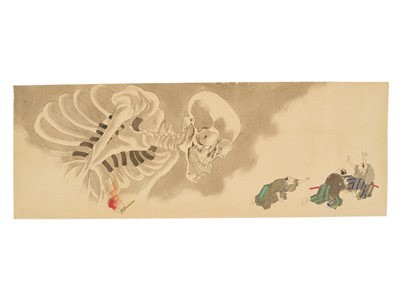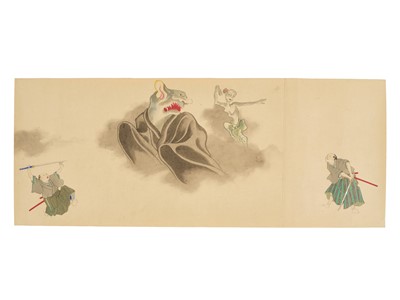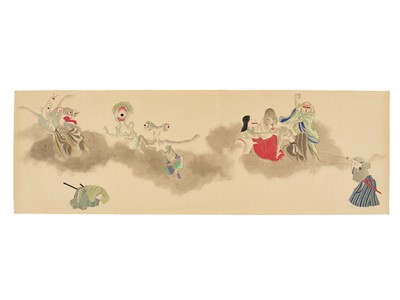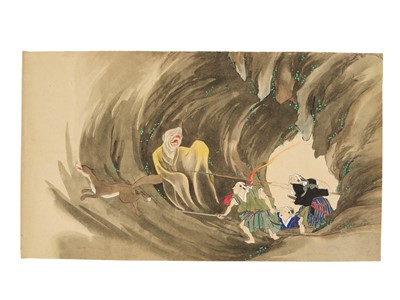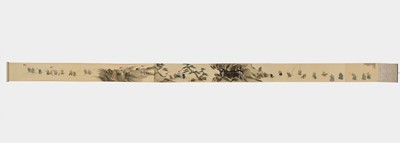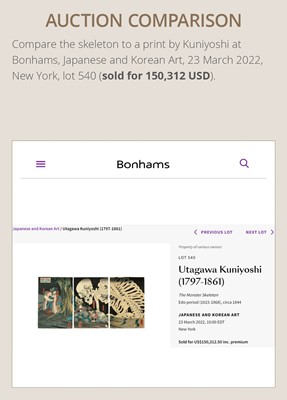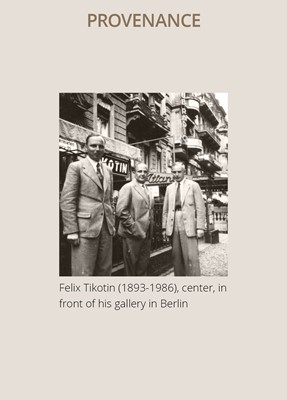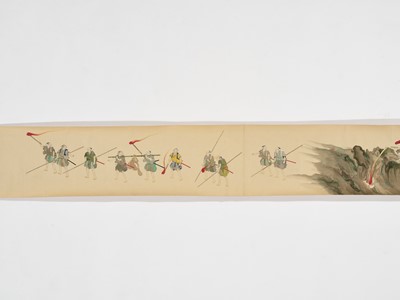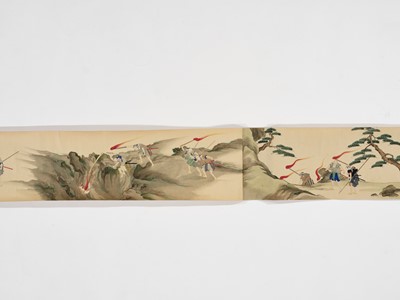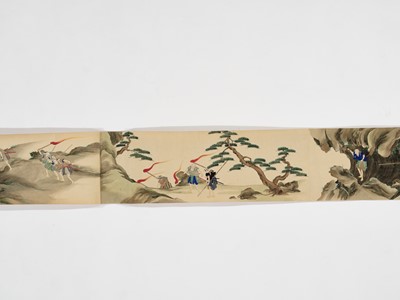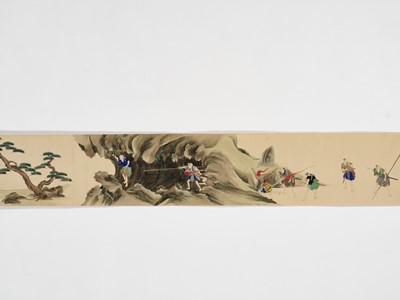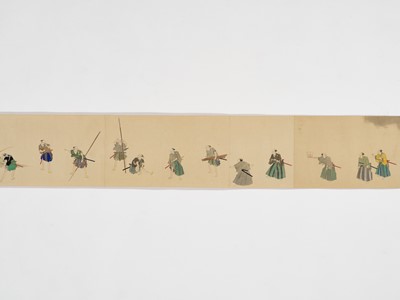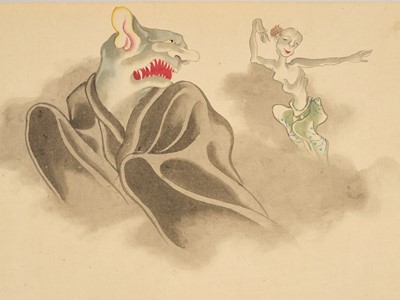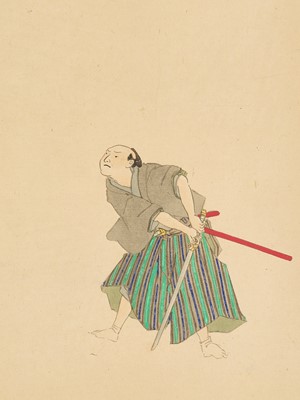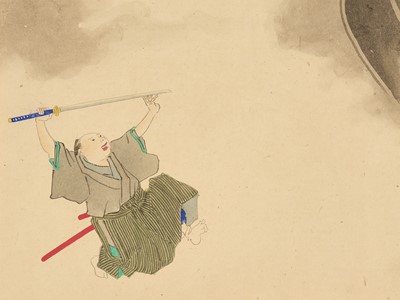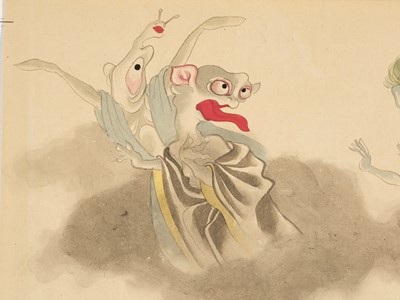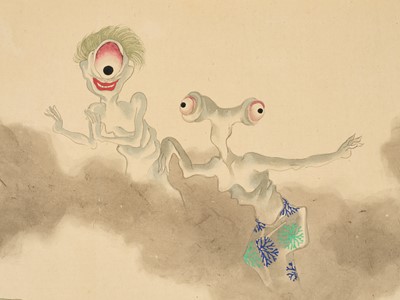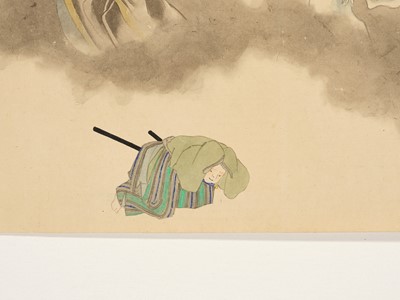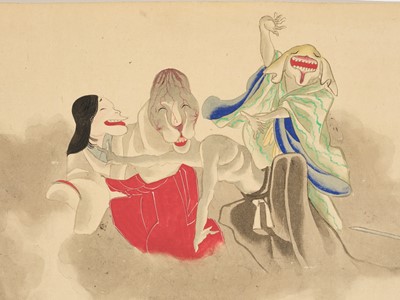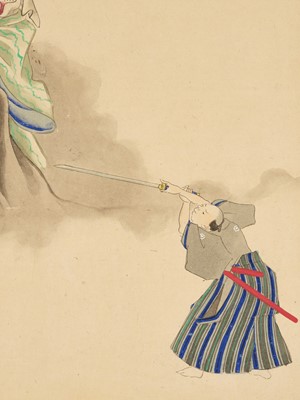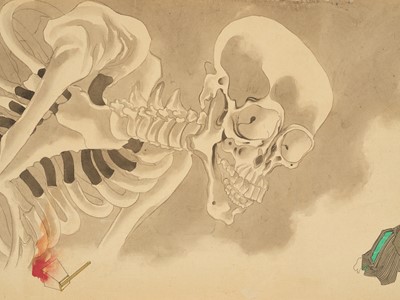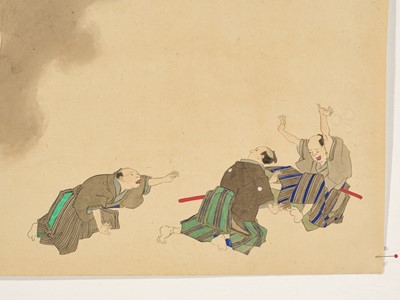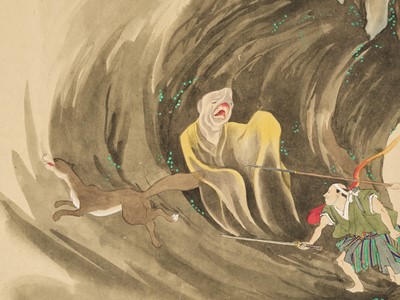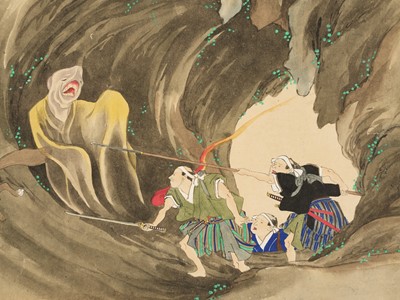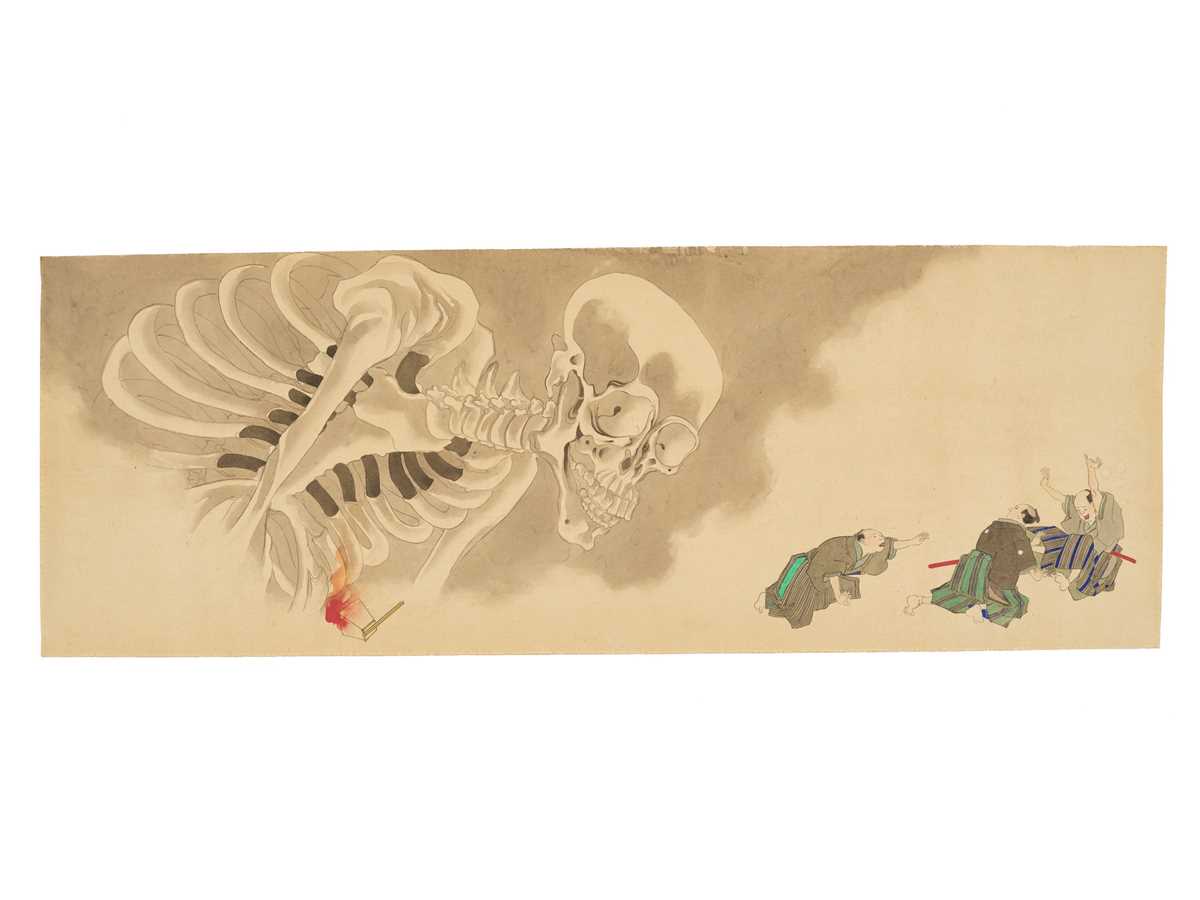16th Jun, 2023 11:00
Fine Japanese Art
77
A LARGE AND RARE EMAKI HANDSCROLL WITH FOUR SEPARATE LEAVES, ONE WITH A DEPICTION OF GASHADOKURO
Sold for €7,150
including Buyer's Premium
Japan, 19th century
Watercolor and ink on paper. Large horizontal emaki scroll depicting villagers armed with swords, sticks, and torches chasing a fox (kitsune) into a cave. The four separate leaves illustrate their journey inside the cave where they are greeted by a large Gashadokuro. As they rush and hide for cover, they are confronted by more yokai. The scroll with stag antler handles.
Scroll: SIZE 29.4 x 600 cm
Leaf (I): SIZE 29 x 80 cm
Leaf (II): SIZE 29 x 88 cm
Leaf (III): SIZE 29 x 73 cm
Leaf (IV): SIZE 29 x 50.5 cm
Condition: Each scroll in a superb state of preservation with fresh colors, the scrolls were evidently stored well. Some minor non-distracting surface wear, little soiling and creasing, few minuscule losses and tears.
Provenance: Family collection of either Felix Tikotin (1893-1986) or his son-in-law Louis (Loek) Borensztajn (1935-2021), Netherlands.
Felix Tikotin (1893-1986) was an architect, art collector, dealer, and founder of the first Museum of Japanese Art in the Middle East. He became one of the world’s leading collectors of Japanese art, starting at the age of 18, and continued to collect and work as an art dealer in Berlin in the 1920s. In the 1930s Felix Tikotin fled from the Nazis and hid his collection in the Netherlands. After the war, he decided that his collection should be taken to Israel, where in 1959 and with the help of Abba Hushi, who was the mayor of Haifa, The Tikotin Museum of Japanese Art was established. The Museum's collection comprises more than 8,000 items of art and crafts.
Gashadokuro is a Yokai made up of the bones of soldiers or victims of famine whose bodies rotted and didn’t have a proper burial. These people die with anger and pain in their hearts. Unable to pass on, their souls gather to form a giant skeleton. As their bodies further decay, they grow angrier and more vengeful, holding a grudge against humanity for what they have. They wander fields in the night their teeth chatter and bones rattle making a “gachi gachi” sound, hence the name Gashadokuro. If they happen upon a human, they will silently sneak up behind them and catch their victim. Crushing them in their hand or biting their head off. Gashadokuro are too large and powerful to be defeated. As such they will wander the fields until the malice stored in their bodies fade away.
Yokai is a term in Japanese folklore that refers to supernatural monsters, spirits, or demons. They are often depicted as strange or bizarre creatures with unusual appearances or behaviors and can range from mischievous and playful to terrifying and malevolent.
Emaki, also called emakimono (or less commonly ekotoba), is an illustrated horizontal narration system of painted handscrolls that dates back to the Nara period in 8th century Japan, initially copying its much older Chinese counterparts. They combine calligraphy and illustrations and are painted on long rolls of paper or silk sometimes measuring several meters. The reader unwinds each scroll little by little from right to left, revealing the story as seen fit. Emakimono are therefore a narrative genre similar to the book, developing romantic or epic stories, or illustrating religious texts and legends. The format of the emakimono, long scrolls of limited height, requires the solving of all kinds of composition problems: it is first necessary to make the transitions between the different scenes that accompany the story, to choose a point of view that reflects the narration, and to create a rhythm that best expresses the feelings and emotions of the moment. In general, there are thus two main categories of emakimono: those which alternate the calligraphy and the image, each new painting illustrating the preceding text, and those which present continuous paintings, not interrupted by the text, where various technical measures allow the fluid transitions between the scenes. Today, emakimono offer a unique historical glimpse into the life and customs of Japanese people, of all social classes and all ages, during the early part of medieval times.
Auction comparison:
Compare the skeleton to a print by Kuniyoshi at Bonhams, Japanese and Korean Art, 23 March 2022, New York, lot 540 (sold for 150,312 USD).
Japan, 19th century
Watercolor and ink on paper. Large horizontal emaki scroll depicting villagers armed with swords, sticks, and torches chasing a fox (kitsune) into a cave. The four separate leaves illustrate their journey inside the cave where they are greeted by a large Gashadokuro. As they rush and hide for cover, they are confronted by more yokai. The scroll with stag antler handles.
Scroll: SIZE 29.4 x 600 cm
Leaf (I): SIZE 29 x 80 cm
Leaf (II): SIZE 29 x 88 cm
Leaf (III): SIZE 29 x 73 cm
Leaf (IV): SIZE 29 x 50.5 cm
Condition: Each scroll in a superb state of preservation with fresh colors, the scrolls were evidently stored well. Some minor non-distracting surface wear, little soiling and creasing, few minuscule losses and tears.
Provenance: Family collection of either Felix Tikotin (1893-1986) or his son-in-law Louis (Loek) Borensztajn (1935-2021), Netherlands.
Felix Tikotin (1893-1986) was an architect, art collector, dealer, and founder of the first Museum of Japanese Art in the Middle East. He became one of the world’s leading collectors of Japanese art, starting at the age of 18, and continued to collect and work as an art dealer in Berlin in the 1920s. In the 1930s Felix Tikotin fled from the Nazis and hid his collection in the Netherlands. After the war, he decided that his collection should be taken to Israel, where in 1959 and with the help of Abba Hushi, who was the mayor of Haifa, The Tikotin Museum of Japanese Art was established. The Museum's collection comprises more than 8,000 items of art and crafts.
Gashadokuro is a Yokai made up of the bones of soldiers or victims of famine whose bodies rotted and didn’t have a proper burial. These people die with anger and pain in their hearts. Unable to pass on, their souls gather to form a giant skeleton. As their bodies further decay, they grow angrier and more vengeful, holding a grudge against humanity for what they have. They wander fields in the night their teeth chatter and bones rattle making a “gachi gachi” sound, hence the name Gashadokuro. If they happen upon a human, they will silently sneak up behind them and catch their victim. Crushing them in their hand or biting their head off. Gashadokuro are too large and powerful to be defeated. As such they will wander the fields until the malice stored in their bodies fade away.
Yokai is a term in Japanese folklore that refers to supernatural monsters, spirits, or demons. They are often depicted as strange or bizarre creatures with unusual appearances or behaviors and can range from mischievous and playful to terrifying and malevolent.
Emaki, also called emakimono (or less commonly ekotoba), is an illustrated horizontal narration system of painted handscrolls that dates back to the Nara period in 8th century Japan, initially copying its much older Chinese counterparts. They combine calligraphy and illustrations and are painted on long rolls of paper or silk sometimes measuring several meters. The reader unwinds each scroll little by little from right to left, revealing the story as seen fit. Emakimono are therefore a narrative genre similar to the book, developing romantic or epic stories, or illustrating religious texts and legends. The format of the emakimono, long scrolls of limited height, requires the solving of all kinds of composition problems: it is first necessary to make the transitions between the different scenes that accompany the story, to choose a point of view that reflects the narration, and to create a rhythm that best expresses the feelings and emotions of the moment. In general, there are thus two main categories of emakimono: those which alternate the calligraphy and the image, each new painting illustrating the preceding text, and those which present continuous paintings, not interrupted by the text, where various technical measures allow the fluid transitions between the scenes. Today, emakimono offer a unique historical glimpse into the life and customs of Japanese people, of all social classes and all ages, during the early part of medieval times.
Auction comparison:
Compare the skeleton to a print by Kuniyoshi at Bonhams, Japanese and Korean Art, 23 March 2022, New York, lot 540 (sold for 150,312 USD).
Zacke Live Online Bidding
Our online bidding platform makes it easier than ever to bid in our auctions! When you bid through our website, you can take advantage of our premium buyer's terms without incurring any additional online bidding surcharges.
To bid live online, you'll need to create an online account. Once your account is created and your identity is verified, you can register to bid in an auction up to 12 hours before the auction begins.
Intended Spend and Bid Limits
When you register to bid in an online auction, you will need to share your intended maximum spending budget for the auction. We will then review your intended spend and set a bid limit for you. Once you have pre-registered for a live online auction, you can see your intended spend and bid limit by going to 'Account Settings' and clicking on 'Live Bidding Registrations'.
Your bid limit will be the maximum amount you can bid during the auction. Your bid limit is for the hammer price and is not affected by the buyer’s premium and VAT. For example, if you have a bid limit of €1,000 and place two winning bids for €300 and €200, then you will only be able to bid €500 for the rest of the auction. If you try to place a bid that is higher than €500, you will not be able to do so.
Online Absentee and Telephone Bids
You can now leave absentee and telephone bids on our website!
Absentee Bidding
Once you've created an account and your identity is verified, you can leave your absentee bid directly on the lot page. We will contact you when your bids have been confirmed.
Telephone Bidding
Once you've created an account and your identity is verified, you can leave telephone bids online. We will contact you when your bids have been confirmed.
Classic Absentee and Telephone Bidding Form
You can still submit absentee and telephone bids by email or fax if you prefer. Simply fill out the Absentee Bidding/Telephone bidding form and return it to us by email at office@zacke.at or by fax at +43 (1) 532 04 52 20. You can download the PDF from our Upcoming Auctions page.
How-To Guides
How to Create Your Personal Zacke Account
How to Register to Bid on Zacke Live
How to Leave Absentee Bids Online
How to Leave Telephone Bids Online
中文版本的操作指南
创建新账号
注册Zacke Live在线直播竞拍(免平台费)
缺席投标和电话投标
Third-Party Bidding
We partner with best-in-class third-party partners to make it easy for you to bid online in the channel of your choice. Please note that if you bid with one of our third-party online partners, then there will be a live bidding surcharge on top of your final purchase price. You can find all of our fees here. Here's a full list of our third-party partners:
- 51 Bid Live
- EpaiLive
- ArtFoxLive
- Invaluable
- LiveAuctioneers
- the-saleroom
- lot-tissimo
- Drouot
Please note that we place different auctions on different platforms. For example, in general, we only place Chinese art auctions on 51 Bid Live.
Bidding in Person
You must register to bid in person and will be assigned a paddle at the auction. Please contact us at office@zacke.at or +43 (1) 532 04 52 for the latest local health and safety guidelines.
